|
|
Post by 4real on Aug 20, 2013 22:09:25 GMT -5
Thanks...yes going through the options, this seems like a good list of features... I envison using a bit of compression on the mag pup to provide the sustain and warmth under the immediacy of the 'acoustic' piezo sound less compressed, I may even add an internal mic such as this cost effective GHS... www.stewmac.com/shop/Electronics,_pickups/Pickups:_Guitar,_acoustic/GHS_Acoustic_Soundhole_Microphone.html?actn=100101&xst=3&xsr=379203&tab=Details  I'll have to have a good look inside the guitar next string change as to how it might fit below the 'string doctor' device and would require making a second output jack and to move the battery so it can be got to more easily...and likely modifying the stereo led to incorporate a third signal perhaps...the idea to get a bit more of the 'natural sound' and 'body wood' and yet a 'third signal' to the mix perhaps... The EQ's are of course a crucial element to sculpting this kind of layered sound. It seems from the manual that the internal effects are muted when the aux is used which is not the best if so. I am considering using stomp box effects on the mag channel perhaps to add some 'colour'...possibly a multi-effects unit of the like. I found and fixed the 'fault' in one of my studio monitors too that would provide a nice 'stereo' lower level option and could be mounted on small 'stands' for an interesting alternative amplifier set up. But yep, all these things and the power of this mixer and such can only be effective if one has an amplifier that can handle a fuller range of frequencies and so doing this amp mod will be a useful thing. And $30 bucks is a really neat and cost effective and flexible modification to the roland where loundness' is paramount and looking forward to having a go at it in the near future... |
|
|
|
Post by 4real on Aug 22, 2013 23:56:02 GMT -5
This is what Ive worked out for a rotary controller of two horn piezo tweeters:  Parts arrived today...resistors are smaller than i feared tehy could be so that will make it neat. I intend to mount the components on a board and will see if I can rig up some kind of 'jumper' for teh caps and dual 56 ohm resistors so things can be chaged easily if that is an advantage. Still investigating the mixer as this is a major purchase. I might consider the QX1204 for the better effects over the X1204...still considering the options... GFs coming over today, so, well if it is still raining, we might do that together, or will have to wait till shes gone. I think I ahve a hole saw of a suitable size... Im considering options when the mixer and such is chosen to make some kind of amp stand/trolly/mixer and effects storage, cables and such and possibly a seat, with wheels to make it more transportable...any thoughts for that side of things? Oh...and do you think it helped and what is the purpose of angling the tweeters like that, I imagine it could be possible to do if it is advisable and the tweeters will likely be hidden pretty much... |
|
|
|
Post by JohnH on Aug 23, 2013 2:36:14 GMT -5
Ill have to 'fess up about the angled tweeters because I didnt think about them untill I discovered that I had cut slightly too small a hole in the baffle. I hadnt allowed for the radius where the conical body of the tweeter meets the front face plate. So I couldnt get them flush and could only screw them fully down at one side. But rather that opening out the hole some more, I decided that an upward and outward angling might help with dispersion. But I never did a test to find out how much. My grill cloth is mounted on a frame that leaves about a 20mm gap in front of the baffle, so there was enough room. I thnk they are only lifted about 10mm on one side.
A nice idea to build the case. Bunnings is a good source of wheels and castors of various sizes. Ive bought quite a few therd to add mobility to speaker cabs, furniture and shed projects. I think it should be black, a bit beaten up, and with some scuffed tour labels. After all, you are a proffessional musician!
|
|
|
|
Post by 4real on Aug 23, 2013 6:22:40 GMT -5
Ill have to 'fess up about the angled tweeters because I didnt think about them untill I discovered that I had cut slightly too small a hole in the baffle. I hadnt allowed for the radius where the conical body of the tweeter meets the front face plate. So I couldnt get them flush and could only screw them fully down at one side. But rather that opening out the hole some more, I decided that an upward and outward angling might help with dispersion. But I never did a test to find out how much. My grill cloth is mounted on a frame that leaves about a 20mm gap in front of the baffle, so there was enough room. I thnk they are only lifted about 10mm on one side. A nice idea to build the case. Bunnings is a good source of wheels and castors of various sizes. Ive bought quite a few therd to add mobility to speaker cabs, furniture and shed projects. I think it should be black, a bit beaten up, and with some scuffed tour labels. After all, you are a proffessional musician! Well, I suspect I can find an appropriatesly sized hole saw...cool. The 'case things...well, suspect I might do a bit more furniture than roadie black LOL....that is a fair way down the track though i think, after the move at least. I am hoping to find a place with a proper workshop or garage. I got the monitors working again though and they can sound really good for a small/mdium sized room...so I might well go ahead with the stands idea for that...and see if I can convince GF that with all this rain, we might do a bit of amp modification ;-) |
|
|
|
Post by newey on Aug 23, 2013 9:20:47 GMT -5
If her eyes don't glaze over when you mention "amp modifications", keep her close by your side . . .  |
|
|
|
Post by 4real on Aug 29, 2013 2:14:01 GMT -5
GF is fine about stuff like amp modification, she might not quite 'get it' but she likes the idea of drilling holes in things and does a fair bit of DIY and craft type things...
Meanwhile, life taken over and ill health for a bit, but all the parts are here from jaycar to do this mod and weather seems to be slowly improving.
Have not yet bought a mixer, but settling on a QX1204usb...in large part for the improved effects...it can wait a little more, rent week and hitting the roo took a chunk out of a tight budget.
Meanwhile, been playing a lot of guitr and improving...
And...potentiually another project for this guitar. With a mixer I can have many inputs, the guitar is already modified to be stereo mag/piezo but have been considering a third 'internal mic' I am a bit concerned if there is room for something like that GHS mic now that there is a JLD in there,,,so...
Such is the time for some DIY perhaps...
The intention of teh internal mic would be to capture the internal resonance. Low/nil noise is optimal and limiting feedback is important too...don't what it to pickup too much extraneous sounds form the act of playign the things either. Likely it would be at a very low volume compared to the other sources.
So...DIY Options. Electret capsules are about $2 for instance and something could be rigged up I imagine...so how are such things powered, can the stereo lead be modified for another signal...how and where should one mount it, what cost and all that...potentially it could be phantomed powered perhaps...or perhaps a small battery on the amp end in some way...any thoughts.
...
|
|
|
|
Post by JohnH on Aug 29, 2013 4:54:23 GMT -5
Hi Pete - sorry to hear you have been ill. When you get into the tweeter system, Im hoping you will wire something up temporarily first, before committing to cutting any holes in any amps. The cross-over design had more analysis than I'd normally do before hooking something up, but there's no guarantee that you'll like it!
On microphones, Im not sure. Ive paid considerably more than $2 for some truely terrible mics!
cheers
J
|
|
|
|
Post by 4real on Aug 29, 2013 5:51:48 GMT -5
Hi Pete - sorry to hear you have been ill. When you get into the tweeter system, Im hoping you will wire something up temporarily first, before committing to cutting any holes in any amps. The cross-over design had more analysis than I'd normally do before hooking something up, but there's no guarantee that you'll like it! On microphones, Im not sure. Ive paid considerably more than $2 for some truely terrible mics! cheers J Thanks, hopefully not serious, just the stress effects can knock you about and with the prospect of moving and such creeping closer, not good timing...neither was knocking out the car with a roo...so been a run of things. I think the tweeter idea is reasonably safe to mount...but I see your point. If I don't like it, it will of course ahve an 'off' setting anyway, but you seem reasonably satisfied with your cab and more basic options, so i have every confidence. It may not be the 'perfect' solution, but I ahve little doubt it will give more of the high frequencies and will certainly be capable of a fair volume. I will be doing a 'side project' with the stereo powered monitors which is likely to suffice in many ways and be exploring other 'compact' solutions too I think along those lines...but for 'brute power' the roland has got that...I'd hoped to do a test first, but with the way things are...well, got to do a layout for the circuit and such...see how the times goes...GF's practically living here lately so, you know...hmmm I'm a little reticent to drill another hole in the guitar for anothe jack, so would ahve to experiment. The mixer will have quite a bit of tone shaping capability as well...though I would not want to add noice into a pretty noisless system so far. The idea of a mic would be add some of the tonal complexity of the internal resonance that neither mag or piezo pickups can sense, but subtly and with minimum feedback. Lavalier Microphones or the kind of thing one might find on a kind of gooseneck on a cheap headset mic might be ok for instance, they are fairly cheap. They run however off a computers power...so some kind of power arrangments would likely be need, but the rest could be handled on the othr end of the system. All pups share a ground, though it may be even possible to separate 2 cores and the shared ground for a mic in the existing stereo lead which is made from 4 core quality cable. A battery might be used attached to the lead, perhaps from the phantom power or maybe eve attached to the internal battery, though after the drain in the last project with mixing systems like that, I am a bit wary of that approach. A 1.5v battery might be able to be added to the mounting system of the mic in the guitar. www.jaycar.com.au/productView.asp?ID=AM4011 www.jaycar.com.au/products_uploaded/AM4011.pdf www.jaycar.com.au/products_uploaded/AM4011.pdfI suppose there is the potential in taking out a dynamic mics insert...though that is uncommon, it might offer a passive solution and not be too big. Looking for the high frequency harmonics I guess...and I suspect one might be able to mount a baffle around the mic to provide some directionality... just a few preliminary thoughts... |
|
|
|
Post by 4real on Sept 3, 2013 3:37:05 GMT -5
Ok...well took a bit of doing, but got it working and installed...so here, with a fair few pictures is the TWEETER MODIFICATION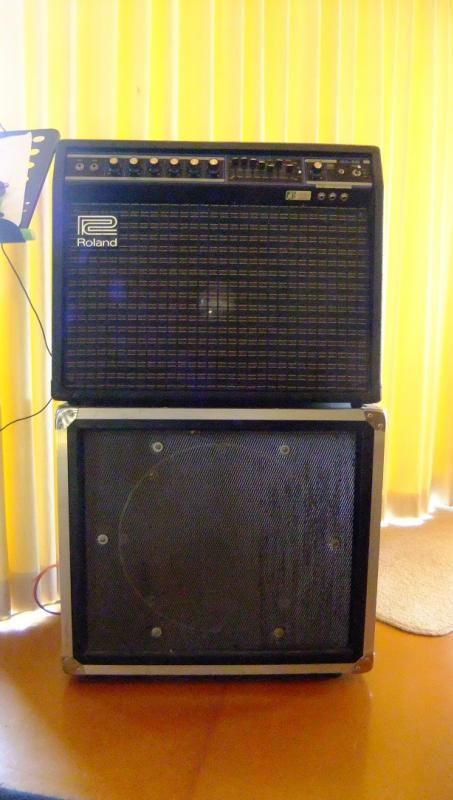 Above is the Roland GA 60, sitting on my extension 15" bass cab. This amp is a loud 60 watts and has een super reliable, sve for a few scratchy pots. It is a super clean sound, similar circuit to the Jazz-chorus models but with a deep reverb, 5 band EQ and overdrive, master and pre volume. This was my first proper amp as teen and has been super reliable for way more than 30 years and I used it in bands and was plenty loud enough to play small venues with a loud drummer The mission, is to add a pair of tweeters to give it more of a 'full range', especially for the acoustic to amplifiy thoe harmonic transients and details in a piezo guitar, or indeed, would make one very loud 'mini PA or mono amplifier to play an I pod through LOL... 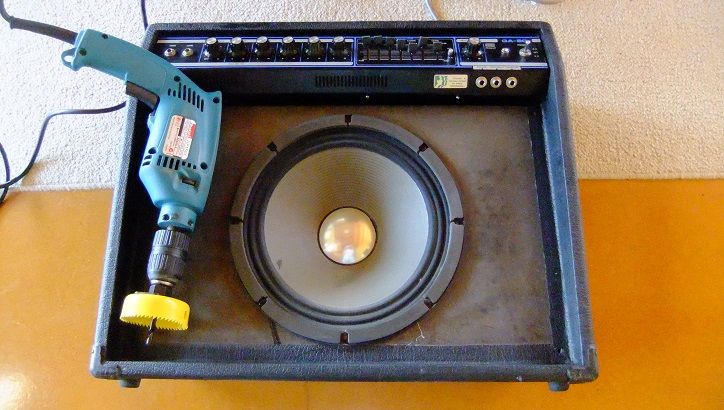 These tweeters require a 3" hole and fortunately, I have a hole saw exactly the right size...measure carefully, make sure there are no speaker wires or anything behind them and they fit, test the grill as well and measure twice to be sure. 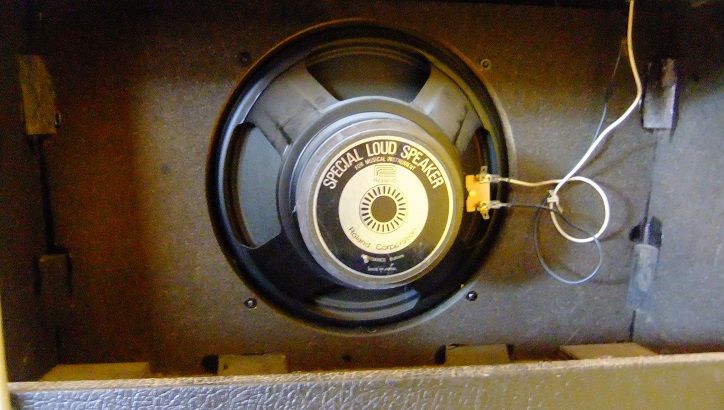 In this 12" combo and there was plenty of room either side of the main speaker. Drill a pilot hole and cut holes... 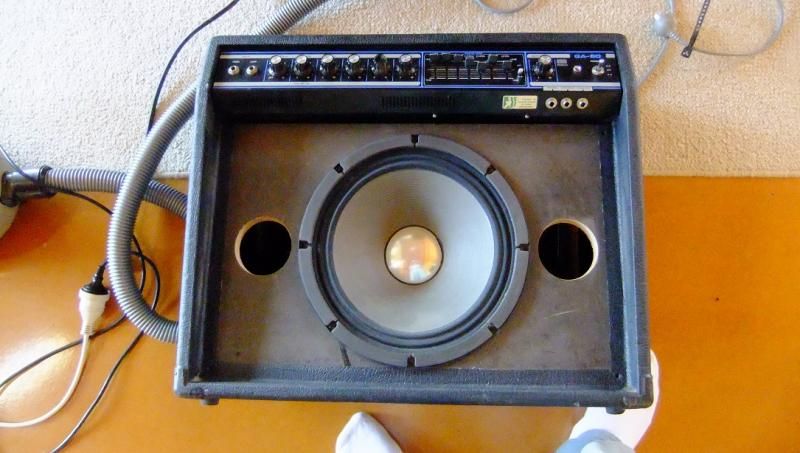 Keep the vacuum cleaner handy to pick up the dust and such...I took the oportunity while thins wer apart to give things a bit of a brush out and clean... 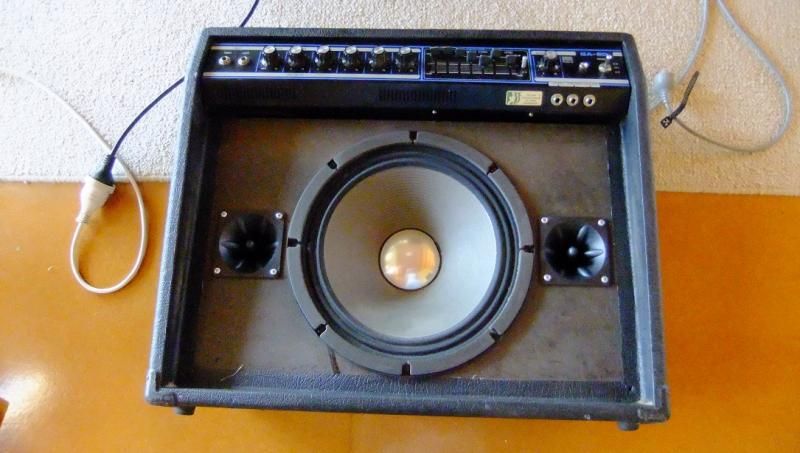 Fitted really well, they are pretty much invisible behind the grill... Inside the cab... 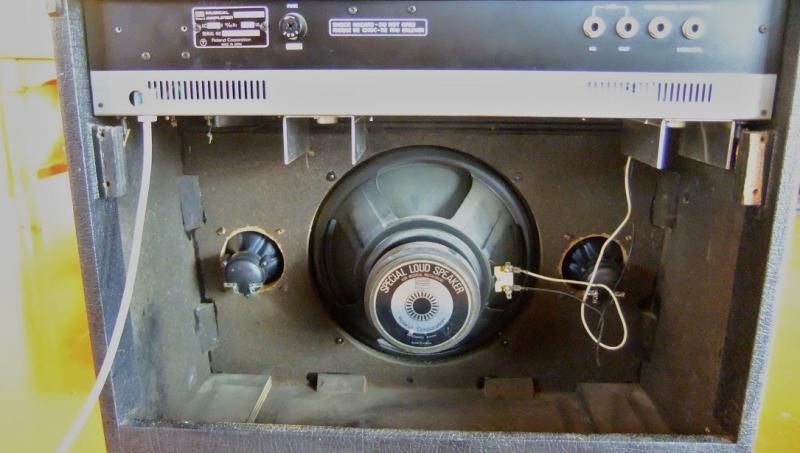 Inside the amplifier I saw there was room in an area where there might have been room for another circuit, likely for the special 'compressor vesion' I imagine...but not used...hmm... 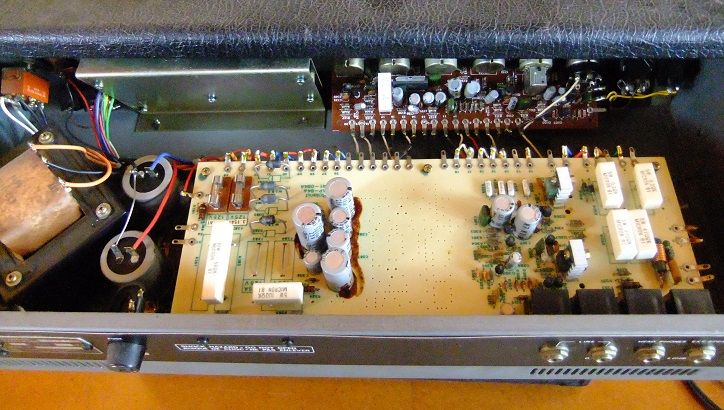 I'd done a layout the other evening...will need to check it before posting as there was an error that need fixing...but pretty much as john wrote it out but 'zig-zagging' the 5W resistors...flying leads to the rotary switch. It is built on 'perf board' without tracks and using thicker speaker lead wires. I added a mini DIL switch to switch the caps in and exra 56 ohm resistor in parallel for a couple of other 'flavours'. As John designed it, there is an off position and 5 variation of activation/volume of the tweeters. This is the back of the circuit board... 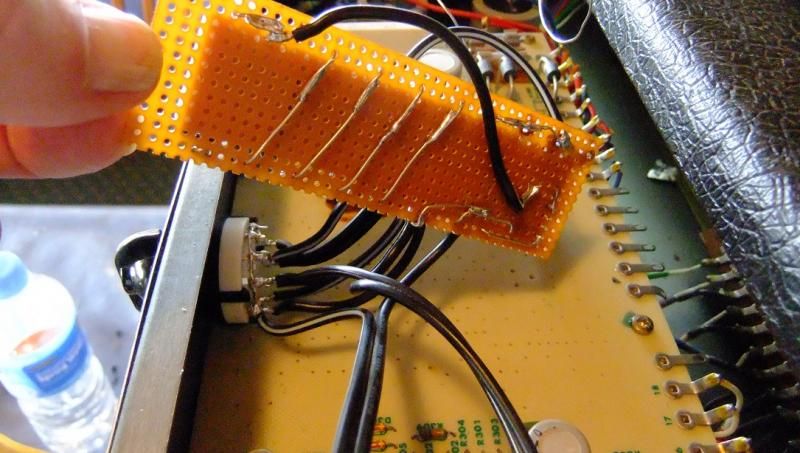 and the 6 position rotary control... 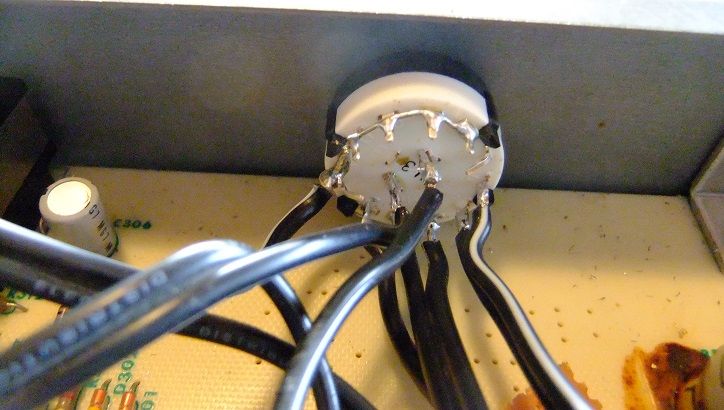  And so, installed...I stuck the board to the 'blank board' with some double sided foam tape that will insulate it well and hold tight. The tweeters are hard soldered to the speakers off the board inside rather than to the speaker itself to make things neater... 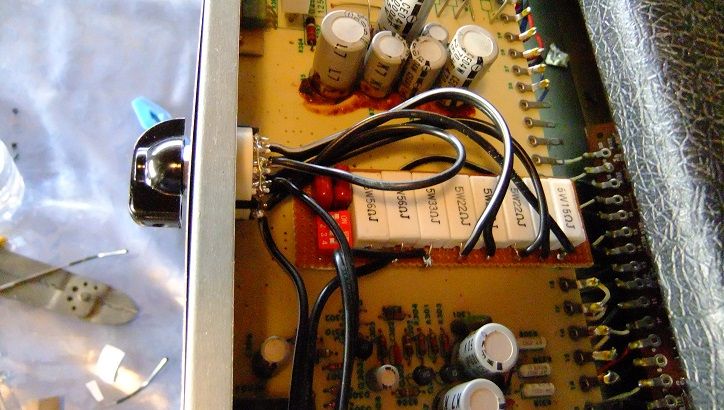 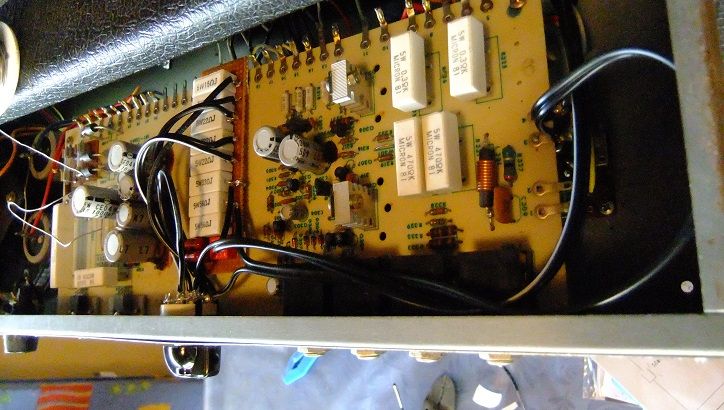 Once tested and installed, I used a small chicken head switch at the back, horizontal bing 'off'... 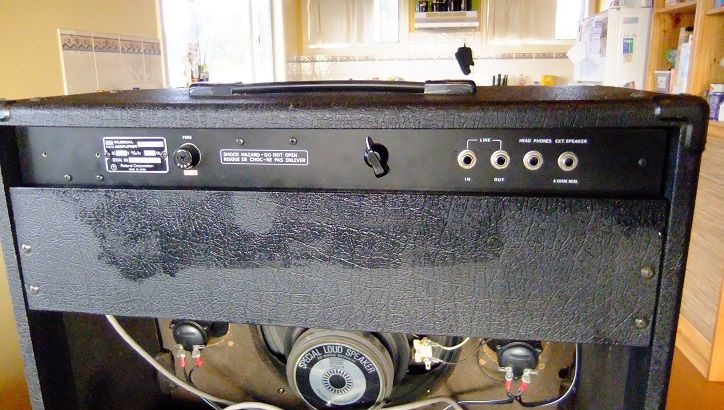 ... Ok...so took quite a bit of fiddling around, but got the job done...so how does it 'sound'? First, 5 positions is plenty, they are fairly subtle variations. With the acoustic, I tend to like the 3rd or middle position best, subtle but a noticable difference, but all could have their uses. On 'max' you really do notice the 'tinsel' effect of that high end, but perhaps a bit much for most uses...the other end is very subtle and not at all 'shrill' which I was concerned about. I tested the switch and there are differences, subtle, but seemed to be best as drawn by John, so left it like that, I wouldn't think that is necessary or worth a separate switch or anything, adding the switch allowed testing. It does make the amp a lot more 'full range' though I've only done a little testing with the piezo side of the acoustic. There is no added hiss or noise or switching noise, completely silent. It is a very silent amplifier and adding the high end capability did not bring out any extra high end noise, another possible concern. I imagine that this could be used for vocals or hi-fi party amp or as an acoustic or just to add a little extra definition to an amp...perhaps if one were to use it for gutar and a 'backing track' to play along to and wanted to bring out the sizzle and snap of a drum machine...or that is perhaps where the more subtle variations would make for a good addition for electric guitar. So for $30 a very nice and unusual project. The rotary control is a great modification to John's original project providing a single neat rotary control for 'off' and 5 useful variations. The idea of a variable control was interesting, but not as good and more difficult really, there will not be much between these five settings, even the other variation possible did not seem that useful, so mine is set to the original design as john posted it. Tips? Well...use a decent 3" hole saw and powerful drill for best results. One could rasp or rout the edges of a smaller hole to make the tweeters sit flat (john LOL). Measure carefully and more than once and drill pilot holes for the screws and such. You need not actually open up the amp and mount the circuit inside. You could include the switch onto the perfboard and use that to secure it to some aluminium say, or some baffle in the cab perhaps, and mount the control in the cab and connect the hole thing inside and directly to the speaker itself. If onening things up, take a lot of care not to touch anything!! I had some spade bits from a cheap crimping tool that attach the tweeters to the circuit. This would enable, like the main speaker, to be disconnected if I needed to take the whole amplifier section out without desoldering. That also enables, I guess, the possibility of pulling out one of the tweeters so only using one for 5 other variations. Another possiblility might be to build a separate 'tweter box' and adding that to any amp speaker...an interesting proposition. Even bass players might consider this kind of thing to get that extra 'snap' as I see tweeters are common on bass amps. So...thanks a lot John. Still not a 'mixer' yet to get the most out of it for my application, but well worth while doing for some mono brute force full range power should I need it...I still like the idea of running stereo and working in that direction as well, but this is worth while and might even consider doing it again on the other amp in time... |
|
|
|
Post by JohnH on Sept 3, 2013 4:23:47 GMT -5
Great! Nice write up, and Im very glad that worked out for your grand old amp.
I was nervous (not actually worried!). I was hoping it would turn out, as it seems to have done, with max being a bit too much and min being not very much, and some subtle steps in between to find the best setting. Ill probably rewire my system in a similar manner.
cheers
John
|
|
|
|
Post by 4real on Sept 3, 2013 8:26:44 GMT -5
Great! Nice write up, and Im very glad that worked out for your grand old amp. I was nervous (not actually worried!). I was hoping it would turn out, as it seems to have done, with max being a bit too much and min being not very much, and some subtle steps in between to find the best setting. Ill probably rewire my system in a similar manner. cheers John Well, five settings is generous and was pretty sure that one would work out ok but could see some use for other settings, it is a fairly subtle effect but does make quite a bit of difference extending the range. I was more concerned that their might be some kind of his or treble brittlness (just comes in at the max setting) but then, there is always the 'off' option. The dual 56k in parallel did not make a lot of difference and I am using both caps, so it could be made simpler and a little smaler without those options. I did occur to me though that It probably does not need a dp6t swtich and these are adjustable with a pin, so you could take a single throw to off and and 10 variations if one would seek to go nuts. One side does seem to be a little redundant as all but 'off are connected and if one side were connected it would still be off...as I see it. But really, the effect is so subtle in this usable range, it's tricky to know if that owould be worth it and these resistors are reasonably big. I wonder what the effect of just having one tweeter? would the values need to be recalculated, as for some a single tweeter might surfice and be easier to fit and cut a third off the cost as well. Anyway, worked out well for what it is... Hope to get a mixer soon and have fixed my monitors for an interesting true hi-fi option that will be interesting and a different more 'surround sound' kind of effect. To get the most out of this guitar, it really needs that kind of tone shaping on the separate pickup systems even if in mono. But compared to getting an 'acoustic' amplifier, this kind of thing is a realistic alternative to give that kind of range out of a decent clean SS amp. This amp I recall being used as a mini PA for vocals in the past when a PA broke down, and sounded better than the PA for that task, certainly enough for rehersals, but this was actually on a gig! Something to consider for people wanting to jam or garage band. Vocal amps have always been an issue in the past in my experience and these added tweeters would greatly add to the vesitility. My fender valve amp is still sidelined and in need of repair...it just goes to show how bullet proof this kind of amplifier is...and if into modeling and such, ideal for that kind of thing...so glad I kept it, though I doubt anyone would pay anything for it! |
|
|
|
Post by 4real on Sept 9, 2013 7:30:42 GMT -5
Got a mixer today, will be a few days till I get to play with it but integreal to my ambitions for this project... www.behringer.com/EN/Products/QX1204USB.aspx I opted for the slightly more 'deluxe' version, in large part for the extra high quality effects and progamable parameters and extras such as 'gain' controls...will report more on it as I try it out over the next few days.. |
|
|
|
Post by 4real on Sept 10, 2013 1:03:55 GMT -5
A quick report on this project. The mixer is taking quie a bit to get my head around...a fair bit of the 'problems' are that I think I will need to get or make some diofferent leadssome different leads to connect to the variaous amp options. It works from teh conttrol room outs through the small powered studio monitors well.
The mixer though shows how well the tweeter mod worked though with several usable ways to hook things up to it, either as a line in bypassign teh controls, or on the low input, or even the 'high' though that is a little bright it seems. Several of the different tweeter control positions work well and can be seen to be useful now I've been able to test it with the full rig, though what I need is to XLR connectors to mono I beleive, probably an adapter and a normal lead should do it.
If I do the quieter stereo rig, I might have to buy a bunch of cable and the like...so will continue testing to see how good I can get if from here.
|
|
|
|
Post by JohnH on Sept 10, 2013 3:17:51 GMT -5
The mixer looks great. How sre the effects?
The Soundcraft mixer I use can give main outs as 1/4" or XLR, and there is some secondary rca sockets I put to a 3.5mm jack into the pc line-in.
I think Ive run out of enthusiasm for wiring any normal kind of lead. Its too much of a PITA, especially XLR. I stockef up when Allens/Billy Hyde went down last year.
On the tweeter mod, Id like to ask if, when you have settled with it, do you think the relative increments between the 5 'on' settings would be better adjusted? The steps were picked following the one pass of tests that we exchanged.
J
|
|
|
|
Post by 4real on Sept 10, 2013 13:41:43 GMT -5
The mixer looks great. How sre the effects? The Soundcraft mixer I use can give main outs as 1/4" or XLR, and there is some secondary rca sockets I put to a 3.5mm jack into the pc line-in. I think Ive run out of enthusiasm for wiring any normal kind of lead. Its too much of a PITA, especially XLR. I stockef up when Allens/Billy Hyde went down last year. On the tweeter mod, Id like to ask if, when you have settled with it, do you think the relative increments between the 5 'on' settings would be better adjusted? The steps were picked following the one pass of tests that we exchanged. J OK...it's taking a little time to get my head around this, especially as the documentation is pretty bad with behringer things and this is a fairly complicated device. It is designed I guess for studio and radio/podcasting with 'controlroom outs and all that...the main outs are XLRs which would be fine to go say to my studio monitors that have both TRS balanced phone and balanced xlr. I had problems with them too with the PC and audio interface and require a hum destroyer (DI box) to avoid ground noise. The Behringer HD400 is a cheap passive TRS phone device that eliminates that problem. I dont seem to have to use that with the mixer into the monitors which is good though. But, the TRS out are only available for the 'control room outs' and alternate mix 3-4. So, there are 'mut' and solo switches that route the signal to or exclude fromthe main mix to these alternate channels. One can imagine one would need that in say a braodcast where comenators with headphones on might wish to comunicate on a separate channel while other material is going out of the main mix. Hmm...so more than I'd ned there and confusing. The mixer also has RCA ins and outs for recording or playing in from say an MP3 player and stereo channels for things like keyboards and the like. So...to get a signal out to say the tweeterised mono guitar amplifier...well, i can test it by panning all to one side and using a standard phone lead into various inputs...hi and low or the line in whihc bypasses the guitar preamp. All sound a bit different, the 'low' seeming to be best, the normal guitar input overly bright (with all controls nutreal and the same) and the line in similar to the 'low' but less 'effected' and slightly 'dull' by comparison. So...how does one get the main outs into the mono amp is a bit of a question and raises some other concens that you might be able to assist in John, or indeed others. One obvious way one might do this is to just take the RCA recording outs into a mono phone. I had thought, ok, simple, get some RCA leads and cut off one end and attach a phone end to mono. But after a little bit of a look around, I found suggestions for a small resistor network advised to do this...  I now wonder, with my stereo out of the guitar, I made a similar basic Y cable, shileds all joined and common, but separate hots to separate phones...for the active piezo and passive mag systems in the guitar. Might this too benefit from this kind of thing or other procedure? Similarly...is this network required to take the stereo outs and make them 'mono' for use with this mono guitar amp? ... So due to thiese kinds of complications and havign to get my head aroudn it, hard to do any kind or reasonable review. The mixer is quiet and has good gain and simple compression adjustments, a very nice EQ and all that. The Effects section...well I ahd hoped that the LCD with actual letters would be better than numbers as with most units, especially with multi effects where there are so many..but alas, you need to be looking directly at or down on the display to read the thing...doh!! Never mind. The effects are good quality and easy to use though. There are 32 and each has 3 parameters that can be programmed and customised. There is also an easy 'tap' button which allows the time of things such as delays to be very quickly altered on the fly. They are largely time based effects and set up fairly 'mild' though, without going to the main outs, a little tricky to really assess that either, especially in mono. But they are very quiet and quite 'lush' and of course be programed to suit. SO, a range of various reverbs by room size etc and a few odd ones like reversed thrown in. Then there are the mod things like chorus, flanger, phaser and trem/pan. There is a 'detune' and pitch shifter but not sure that it works properly with a polyphonic instrument like a guitar, perhaps it's more for 'voice' so will have to see with more exploration there. ... The Tweeter thing...well, will have to explore it more. The chicken head control switch makes it really easy to adjust between the 5 setting and certainly is vastly improved for this kind of thing over a standard gutiar amp. ALl the setting have an effect and I did try a few variations now that I have the proper signal going in and is even more obvious and the subtlties of the various positions really do come out. I'll have to explore things a little more to answer your question about the increments, but it seems that we have it about right. I suspect there may well be a bit of variance with each application andthe kind of speaker it the tweeters and complimenting, the 12" in my amp for instance is fairly wide range with it's aluminium dome and all, but there is a significant improvement on the high end. I don't like 'shrill' tweeters and on the more 'max' setting to my ear, it is a bit, but then to somethat might be a good thing, who knows. The lower setting, you know it is there compared to 'off' but not at all dramatic. As I reported earlier, to me 3 is pretty good, but with experiementing with the mixer in, I did turn them down a little so it is nice to ahve that ability. The rotary switch thing, and 5 positions, is perfectly adequate IMHO though. A rheostat infinite control knob would be a PITA frankly, it would get moved and hard to find that 'spot' and keep it there I'm sure, too many options. I dare say a single pole rotary could have been used with 11 positions in this type but that would be too much I suspect anyway. As far as I can tell, it is about right though, gradual noticable setps but no giant 'leaps' from the range of barely noticing to slightly shrill with a preference in the middle...so the ideal 'calibration', no doubt due to your experience and considered calibration which paid off in that regard. Should I do it again, and I may very well do so, I'd skip the options of the exttra 56k resistor thing and the cap options and keep it simpler an smaller as they seemed to have little effect. As the switch is inside the amp, not something I got to play with too much but I suspect is not required. ... So, a few mixed feelings about the mixer, it will certainly do the job, but they are a little much for this one application and hooking it up is a bit much, but I bought it for the options that it could do a lot more should I want to and it does that with stereo USB out...effectively doubling the inputs into the PC for recording when combined with my edirol audio midi interface thing for instance. ... So...what about these stereo to mono options? As I say, there are RCA outs, unbalanced, intended for recording...the manual says the impedance there is 1k and <+20db. There are the main xlr balanced outs, 240 ohm balnanced, 120 ohm unbalanced +28dBu. A phones out 25ohm, control room out, 120 ohm 22dBu. The easiest/cheapest way to got ot the mono amp would seem to be the RCA outs to get the main output over the xlr but, does it need these resistors? Similarly, does my simple Y lead require some modification out, it odes work. I also noticed that the mag pickup is a bit bright and as there are no controls on it, perhaps it would benefit from a 500k resistor or something to simulate that load on it to give more of it's designed nature. ... So, a lot more fiddling around and tinkering I suspect is required but it is moving in the right direction. I've a fair bit on my plate lately on all fronts, such is life, but I'd really like to have the options and eventually a simple system to plug and play...playing the guitar amplified is quite different, the effects change a lot in the way one plays and arranges or can do and you certainly notice the 'sound' of teh pickup systems at volume and getting the kind of 'sound' I am hoping for is being a little elusive, but coming along... |
|
|
|
Post by 4real on Oct 20, 2013 23:11:32 GMT -5
Not had a much of a chance to do much music related projects, but cleaned up these stands and test fitted a small powered studio monitor and the result looks like this...  The monitors are bi-amped and rated between 30-40 watts each, though the speakers are very small really, say 6". These stands I found in the sunday market for $10 the pair ahve a nice solid base and have been able to adjust them to hold the monitors steady. They extend mych like a mic satd between about 3' to 5'. I am thinking that one could perhaps combine this setup with the mixer and say my fender amp in tandem for an even bigger sound if needed and yet still, very compact and not need as much 'loudness' as the sound is spread out in stereo. This will also become my 'HiFi' and computer monitoring and such as well eventually. Anyway, a picture that gives an idea of the direction this project is heading... The modifications to the guitar itself continue to be a success, the top is flat without any movement and perhaps things have settled a bit and sounding better than ever. The tuners have well proved their worth and the stereo pickup system is an improvement but still some thoughts and testing required at some point. The intention is to run the passive mag guitar through an effects box or multi effects adn this will most likely improve any impedance issues, though there seem to be no major issues with the way things are set up. Still considering a mic system as well, but only after I've explored how good I can get things with proper amplification and experimentation...times been tight of late and a house move still hangs in the balance, so not the time to be messing too much with this kind of thing... Oh, and fixed a cheap guitar the other day and sold it in the sunday market (been helping run and organise a permanent stall of my GF and have some future plans there too) after fixing it up a bit. Sold on the first day...in large part because of the setup and ease of playing of the thing...some lessons all round there I am sure for retailers and such... |
|
|
|
Post by 4real on Oct 28, 2013 22:12:22 GMT -5
 A recent picture, though no further work on this project lately, gives an idea of the 'scale' of teh eventual project in relation to the guitar and the direction I hope to move it in... |
|
|
|
Post by 4real on Nov 4, 2013 3:39:26 GMT -5
 Not had the time to do much of late...but got the cables out finally ... The mag in the guitar is to go through a digital processor, such as this Korg AXIG processor...the preamp alone whould help with any impedance mix mathcwith the piezo, the guitar goes in stero into the mixer then out to the pair of powered monitor. These can be lifted on these mic stand like things to a height of 5' ... as i tend to play seated, I am getting a 'dedicated' guitar stool as well in the near future... Hopefully things will improve and get closer to the kind of 'effect' and sound I am trying to create...been a bit of a journey, but not there yet... I ahve been playing a loot in recent times in a double dropped tuning though and getting used to this kind of hybid approach...CGDGBE....gives a much extended bass and so range under the fingers, even though some of the keys are limited a bit, it is a good start and some great sounds in it... As for the effects, I am hoping that with this progamable box, I will be able to put more variety in it...this particular box has a fantastic 'sitar' effect that I've not met it's match. But there are some ofther interesting effects plus the usual amp sims, delays and verbs, trems, chorus, compressor and EQ and pitch shifting, even limited 'looping' like ability...Ive not played with effects for quite a while but it will be interesting what this will allow with the acoustic guitar... |
|
|
|
Post by 4real on Nov 8, 2013 1:16:36 GMT -5
 All lit up. Had a bit of time to tinker with the effected set up. Not yet but coming along and improving. The effects help to shape and separate the acoustic and electric signals and give changes on the fly with an over all reverb to it from the mixer. You can play with the balance of the two signals with the volume control of the piezo on the gutiar, as well tweak the bass or treble if required, such as feedback problems. The stereo mini PA seems to be quite a good way of doing this, you get a nice accurate overall spread of sound that fills a room, without requiring excessive volume... There's a bit of 'cabling' I admit. Power cables from both speakers and mixers, two TRS balanced phone cables at the moment from the 'alt 3-4' outputs (avoiding the xlrs from the amin out for now for now) stereo cable from the guitar, splits one to channel 1 of the mixer for the piezo, one to the effect box, guitar cable to the 2nd channel from the effects box, mag pickup. Power adaptor to the effects box. A six plug space powerboard with master switch allows a single switch turn off of the system. Intend to add an MP3 paluer. velcro-ed to the mixer I suspect with a cable to the RCA inputs, at least for the first experiment and to maximise channels. This leaves two more channel strips and two stereo channel strips spare, for other instruments, mic or as required. Eventually when more 'settled' Will work out some kind of box for it all to pack away intoand make a 'stand' of some kind. A part of me thinks I went overboard with the mixer thoush is sounds good, but a more compact version might ahve made more sense, still you neer know what he future may require I guess... Some of the effects have been particularly nice on the mag pickup, subtle tremolos for instance make a nice background warble without being 'seasick'...even a subtle overdrive can sound niceand give the bass strings a bit of 'growl'. Not sure what effects I will want to use, a small digital effects box is a cool thing, I have two cheap ones to choose from, or I might use stomp boxes or soemething. Ive got more to add to the setup on the way...Im looking to add an MP3 player to use as a hifi or perhaps to create backing tracks for some things and a dedicated chair for practice... Still playing with the deep CGDGBE tuning and it seems to adequatelly cope with those bass range frequecies...being studio monitors, they ahve a very clean crisp and full range of sound production and pretty compact. |
|
|
|
Post by 4real on Nov 16, 2013 21:16:06 GMT -5
 I got a new chair especially for guitar playing! Still awaiting the mp3 player...now thinking, I need another or soemthing similar to have an instant recording facility ~ now that would be cool ~ My guitar always returns to it's case, now wondering if I might use a stand or something, hmmm ~ Trying out various effects with the system, zoom 606, korg AX1G and zoom504II messed with so far, all have diffferent sounds, but perhaps might try stopmboxes as well, to find the kinds of things that work, or go a bit deeper into the programming to suit |
|
|
|
Post by 4real on Nov 20, 2013 19:20:12 GMT -5
|
|
|
|
Post by 4real on Jun 27, 2014 3:30:26 GMT -5
Am looking at doing some mods and 'inventing' as well. Looking at installin an internal mic system and working on a replacement mag pup system that is a lot smaller and less invasive to the passive system currently used...started work on it today. If anyone knows of a pramp design that might be suitable for soemthing of a very low impedance, would be interested. Might have future questions about powering all this 'stuff' as well...
|
|
|
|
Post by JohnH on Jun 28, 2014 19:49:47 GMT -5
Am looking at doing some mods and 'inventing' as well. Looking at installin an internal mic system and working on a replacement mag pup system that is a lot smaller and less invasive to the passive system currently used...started work on it today. If anyone knows of a pramp design that might be suitable for soemthing of a very low impedance, would be interested. Might have future questions about powering all this 'stuff' as well... Hi Pete, It sounds like you need a good mic preamp, whether to amplify an actual mic in the guitar, or a low impedance, low output mag pup. I looked for one a while ago, and I couldn't find a design that was easy to build but also high quality, low noise etc, low power, small etc. Its different to the simple buffers or low-level booster that we had earlier on this thread, which are much easier to find or work out. Would a suitable option ne to take all of this directly out of the guitar as balanced signals, and use your mixer to do the preamp work using mic inputs? |
|
|
|
Post by 4real on Jun 29, 2014 1:39:27 GMT -5
Thanks John... I dont think a long cable is going to help...  I ordered the above, so internal preamp is included... It uses a separate pencil battry and will need to relocate that where I can get to it or get power from the onboard 9v. I'm a bit concerned about that as I ahd trouble with the last one draining power all the time. On this there is a tuner that can operate without being plugged in and may be whythings were not so straight forward last time. www.altronics.com.au/p/k6044-champion-pre-amp-kit/There has been a recent update to the 'champ' kits which this preamp seems suitable prhaps...not sure how sensitive to input impedance it is... I've started building the design and revaluating things...but looking to be about the thickness of the fretboard and promising. Hoping to perhaps ahve a vol and tone on the mag perhaps and may end up having three separate outs rather than the stero lead...or adapting the slead for three signals. Will there be a problem with different earths connected in it from teh three separate systems? The basic idea is similar in size and effect to the shadow nanomag... I am sure that the device will make a noise and be pretty quiet as it is very small but humbucking. Just not been satisfied with the 'solutions' so far. Iget a bit of odd vibrations I think from teh fender pickup. It works but is not able to get close to the strings and takes up a fair amount of space, my design is much smaller and hidedand less colored and wider frequency range. So...as of now, I ahve worked out the design, found the mags and wire and cut some formers...just making some adjustments before sticking it together, working out a machine to windthe dual coils and get to winding. The whole will be set in epoxy to hold it all together... |
|
|
|
Post by newey on Jun 29, 2014 8:16:30 GMT -5
Potentially. We had a similar discussion concerning my stereo Tele design (which has been, unfortunately, languishing due to my crazy work schedule). Ashcatlt strongly advised separate grounds for separate amps, and since this isn't something that could be easily changed after building it, I designed it with separate grounds from the drawing board. This necessitated the use of a switching TRRS jack to switch one pickup in/out depending on whether a cable was plugged into the second "channel B" jack; using only the mono "channel A" jack alone gives both pups into one output.
JohnH, in his experimenting with blending piezo and mag signals, noted that he had to switch the phase at some point. I noted in the video that this Shadow system apparently has a phase switch, although there was only a mention of it and no demonstration. I found myself wondering if the switch was needed, not so much for the out-of-phase effect, but for use in stereo. IOW, did they put the switch on there so that one could swap phase if one was plugged into two amps and one amp was opposite acoustic phase to the other? (i.e., speaker cone going in vs. going out?)
|
|
|
|
Post by 4real on Jun 29, 2014 19:35:20 GMT -5
My concerns with the grounds are largely about how they might interact and that there will be three active systems with at least one runing of 1.5 volts.
I included a phase switch in my mag/piezo multi-tuning guitar, but there was little sonic difference, I believe that is largely to do with cancellation between the pups and feedback potential problems
If phase is a problem, simply reversing teh signal wires would likely aleviate it I think....
First step is to make the acual miniture pickup. I will need a preamp of some kind to get a proper signal out of it....then test it with other systems before insalling.
I am thinking of having three output jacks, though I insalled a fishman switch jack to run the piezo and mag through a stereo lead, it shared the ground. Potentially I could add to the 4 conductor lead, if sharing the ground would not be an issue to signal or power...more info required
|
|
|
|
Post by 4real on Jul 6, 2014 13:39:28 GMT -5
A couple of pics of progress. Took a while and one total failure and another partial...tricky, but seemed to have suceessfully wound this very small stacked HB design...so far. The idea is it is about fretboard height and mount to the top against the end of the fretboard, fits within the space between the current mag pup and the fretboard. It was wound with PVA but intend to set in epoxy some how. The top is tortoiseshell material. Low impedance so will require a preamp, but it's low impedance should provide a wide frequency range. The 7 magnets are arranged in the hope to provide a bit of compensation on the higher strings   |
|
|
|
Post by JohnH on Jul 7, 2014 2:25:46 GMT -5
Pete - The pickup looks very neat. Have you tried it yet, maybe into a mic input?
You may have seen my thread about noise cancelling coils, so im also interested in the practicalities of winding things. I'm curious about what sort of wire you use, and how you control the winding ptocess.
Heres another idea, which may be nearer to a brain f@rt than a thought grenade:
Ive been checking out ideas for very large noise cancelling coils in series. The concept is attractive because they can suck up enough 'anti-hum', with a coil of very low winds and negligible tone-sucking inductance. So taking your low impedance pickup, presumably with not many turns itself, and given the space inside an acoustic, you could get a hum cancelling coil maybe with just a couple of turns of a coil all around the inside of the guitar body. Then you would not need to make the pickup itself hum-cancelling, and that may free up its design in some helpful way?
J
|
|
|
|
Post by 4real on Jul 7, 2014 3:34:15 GMT -5
Pete - The pickup looks very neat. Have you tried it yet, maybe into a mic input? You may have seen my thread about noise cancelling coils, so im also interested in the practicalities of winding things. I'm curious about what sort of wire you use, and how you control the winding ptocess. Heres another idea, which may be nearer to a brain f@rt than a thought grenade: Ive been checking out ideas for very large noise cancelling coils in series. The concept is attractive because they can suck up enough 'anti-hum', with a coil of very low winds and negligible tone-sucking inductance. So taking your low impedance pickup, presumably with not many turns itself, and given the space inside an acoustic, you could get a hum cancelling coil maybe with just a couple of turns of a coil all around the inside of the guitar body. Then you would not need to make the pickup itself hum-cancelling, and that may free up its design in some helpful way? J Hi John, thanks for the interest... I am not sure the wire thickness, I have various wire from teh sustainer experiements, this is probably ablut 0.125mm, so nothing like as thin as pickup wire but still very thin. My counter broke so would the coils by eye to the same size and used a winder thing I built for the 'wafer coils' I used to do that were only 1mm thick and fitted on top of a SC pickup for sustaining... Anyway, a basic thing, it is a mounted portable variable speed drill fitted with a spindle (actually the circle cut for the horn tweeter project and a tensioner and eye hooks and such. I wound it with PVA as that makes things solid As far as I can tell, the resistance of the coil/s is 50 ohms (not K) so pretty low. It is the same wire used on my very, very tiny bass string individual coils which worked and far smaller. I did some work myself on dummy coils and there are other threads here I believe. I had it but my internet is running at 16kbps or soemthing for the next week or so, but there is a guy in Oz making such a thing to build into strats that woorks well, but is sold on a custom basis or something...forget the name, will think upon it. I'm not sure I'd want a gialnt coil in side the guitar unless I were making it as a part of the build...how would one get the thing in there? I had several ideas in mind on ways to do this project, this version seemed to be a good idea for a lot of reasons...the wire is one continuouse wire that reveses direction once the first coil is wound, so there are no connection and the construction is easier and more compact. Due to 'things' and slow connection, I've not followed the dummy thing closely, but my first thought was that it could be perhaps a 'printed' coil rather than a wound coil...etch a printed circuit board with the turns as teh back plate perhaps... As for this idea I am doing, it has many advantages. It is small and light and visually non-intrusive and does not block the sound hole...it's low impedance should mean a very wide frequency range complementing the acoustic guitars qualites and its reaction should take a bit of teh 'quack' of the piezios out and be complementary to that. It will need power, though this kind of guitar needs power anyway...I'm sure I will need help combining the systems, especially the power, as I am going to add an internal mic as well. Today I tried to set the thing in epoxy, worked but could be cleaned up a bit more, perhaps tomorrow. I'll see if I can show a pic of my winder as well...I wound the first by hand and did not work so well and in teh end failed when the wire broke...so definitely need the winder and a lot of care to do in the end. |
|
|
|
Post by 4real on Jul 15, 2014 1:12:33 GMT -5
|
|